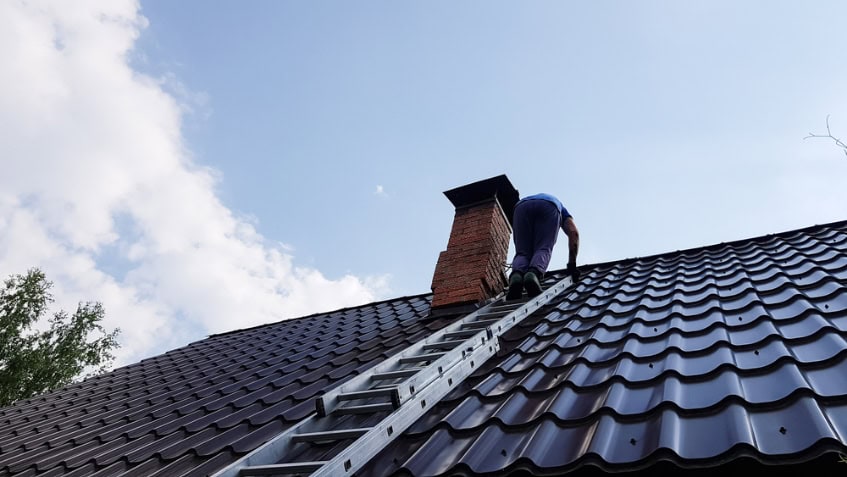
Summary:
Water doesn’t respect how solid your chimney looks. It finds the smallest openings and works its way in, starting a slow but relentless process of destruction that can compromise your entire chimney system.
Providence County’s freeze-thaw cycles make this worse. Water seeps into hairline cracks, freezes when temperatures drop, and expands with enough force to split bricks and crumble mortar. What starts as minor moisture intrusion becomes structural damage that threatens your home’s safety and value.
Your chimney crown acts like an umbrella, directing water away from the chimney structure. When it cracks or deteriorates, water pours directly into your chimney system. You might not notice the damage immediately, but it’s happening—slowly destroying your chimney from the inside out.
Chimney caps serve a different but equally important purpose. They keep rain, debris, and animals out while allowing proper ventilation. A damaged or missing cap creates multiple problems: water damage, blockages from leaves and debris, and unwanted wildlife that can build nests and create dangerous obstructions.
We address crown problems by either patching smaller cracks with specialized, flexible sealants or completely rebuilding severely damaged crowns using proper concrete mixes and techniques. For caps, replacement with properly sized, high-quality materials usually provides the most cost-effective long-term solution.
The key insight most homeowners miss? These repairs are dramatically less expensive when caught early. A $300 crown repair today prevents the $3,000 structural rebuild you’ll face if water damage spreads to the chimney’s interior masonry and your home’s framing.
When you see brick faces popping off or chunks of mortar around your chimney base, you’re looking at spalling—a clear sign that water has penetrated your masonry and is literally pushing the brick apart from the inside.
Mortar joints hold your entire chimney together, but they don’t last forever. Most mortar deteriorates after 25 years, and Providence County’s harsh weather can accelerate that timeline significantly. Failed mortar joints create gaps that allow more water intrusion, creating a cascade of problems that only gets worse over time.
Professional chimney masonry repair involves tuckpointing—carefully removing damaged mortar and replacing it with fresh material that matches both the strength and appearance of your original chimney. For spalling bricks, individual units are removed and replaced with matching materials, ensuring both structural integrity and visual continuity.
This isn’t DIY territory. Proper mortar consistency, color matching, and application techniques require experience and specialized knowledge. Our CSI-certified technicians understand how different mortar types perform in various weather conditions and can ensure repairs that last decades rather than seasons.
Want live answers?
Connect with a Certified Chimney Inspections expert for fast, friendly support.
Your flue liner protects your home from the intense heat and corrosive gases your fireplace produces. When liners crack, corrode, or deteriorate, you’re facing both safety risks and efficiency problems that can’t wait for a convenient repair schedule.
Clay liners crack from rapid temperature changes or previous chimney fires. Metal liners corrode over time, especially when exposed to the acidic condensation that forms during combustion. Either way, a compromised liner puts your family at risk and makes your entire heating system less effective.
Creosote isn’t just unsightly—it’s dangerous. This dark, tar-like substance builds up every time you burn wood, and it’s highly flammable. The more you use your fireplace, especially with unseasoned wood or poor burning practices, the more creosote accumulates in your flue.
Most homeowners don’t realize how quickly this buildup occurs or how dangerous it becomes. Thick creosote deposits can ignite, causing chimney fires that reach temperatures over 2,000 degrees—hot enough to crack flue liners, damage masonry, and spread to your home’s structure.
Professional chimney sweeping services use specialized brushes, rods, and vacuum systems to remove creosote safely and thoroughly. But it’s not just about scraping things clean. Our experienced technicians assess the type and thickness of deposits, identify any damage that excessive buildup might have caused, and provide recommendations for preventing future problems.
The process also includes checking for blockages from other sources: bird nests, leaves and debris, or structural damage that creates obstructions. Any blockage prevents proper ventilation, which can force carbon monoxide and other toxic gases back into your living space—a potentially deadly situation that requires immediate attention.
Flashing creates the watertight seal where your chimney meets your roof. When this metal barrier fails, water finds its way into your home, causing damage that extends far beyond your chimney system.
You’ll usually notice flashing problems as water stains on ceilings near your chimney, especially after heavy rains. Sometimes you can see the flashing pulling away from the chimney or roof surface. Other times, the problem is less visible—deteriorated sealants or improper installation that creates gaps for water intrusion.
Professional flashing repair involves removing old, damaged materials and installing new flashing with proper overlap, appropriate sealants, and installation techniques that account for thermal expansion and contraction. The work requires understanding both roofing and masonry principles to create seals that last.
Quality materials matter here. Different metals work better in different applications, and the sealants must remain flexible over time while maintaining their waterproof properties. We know which combinations work best for your specific situation and local climate conditions.
Proper flashing repair solves leak problems permanently rather than providing temporary fixes that fail within a few years. It’s an investment in protecting both your chimney system and your home’s interior from costly water damage.
The difference between repairs that last and those that fail comes down to experience, proper materials, and understanding why problems developed in the first place. Professional chimney repair isn’t just about fixing what’s broken—it’s about preventing future issues and ensuring your system operates safely and efficiently.
Quality chimney repair service uses materials that match your existing system in both function and appearance. The work follows established safety codes and industry standards while addressing the root causes of problems rather than just symptoms.
When you need chimney repair done right the first time, we bring over two decades of experience and CSI-certified expertise to every project in Providence County.